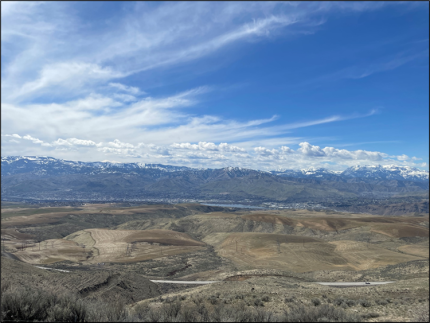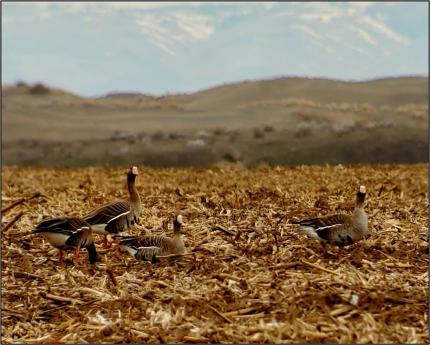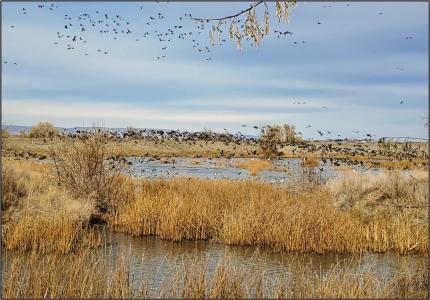Managing Wildlife Populations
Washington Ground Squirrels: District 7 biologists and Scientific Technician Hara have started surveying for ground squirrels in Douglas County. Washington ground squirrels are designated as a Species of Greatest Conservation Need by Washington Department of Fish and Wildlife (WDFW). In the spring/summer of 2023, biologists are surveying historic and recently occupied sites to determine if ground squirrels are currently using these sites. Documentation of active ground squirrel locations can help with this species’ recovery by identifying priority areas of suitable habitat to conserve.
Technician McCallum has been knocking out historic ground squirrel sites within Grant and Adams counties. We are nearly approaching, if not already there, 50% of our sites being surveyed! Washington ground squirrels have been detected in several of these historic sites. Ground squirrel pups are out and about now which should make auditory detections pretty easy.



Furbearers: The deadline for hunters and trappers to have this season’s bobcat and river otter pelts sealed was April 20, 2023. Biologist Eilers sealed quite a few bobcat pelts that came in right before this cut-off date. Successful hunters and trappers of bobcat and river otter must contact a WDFW office for pelt sealing each year and submit the associated harvest report to the Department by the deadline. The sealing process involves placement of a numbered plastic band through a small hole cut into the pelt. This seal identifies the pelt’s origin and indicates that it has been legally harvested. This is to prevent overexploitation of these species, as a taxidermist cannot accept a pelt that does not have a seal. Biologists also record age and sex of sealed animals and use these data to monitor harvest trends.

Northern Leopard Frogs: Biologists Dougherty and Clements with a ton of help from Technicians Bancroft and Kleinhenz have been busy daily conducting egg mass surveys and call surveys for northern leopard frogs. So far, they have detected a total of four northern leopard frog egg masses in the potholes area! Biologist Dougherty even caught a pair of frogs in the act of breeding. Technician Bancroft made the trip with precious cargo and took 200 eggs to the Oregon Zoo in Portland.




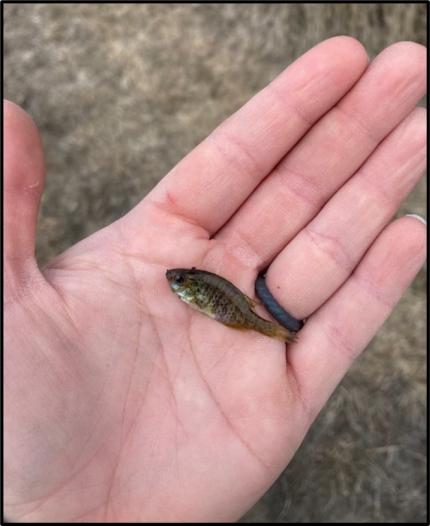




Signs of Spring: The sagebrush steppe is rapidly turning into spring mode. First with the arrival of sagebrush buttercups and now a whole slew of wildflowers are popping up including yellowbells, bluebells, violets, balsamroot, spiny phlox and more! The team was out scouting for pygmy rabbit burrows when Biologist Gallie spotted a spring pool. Inside, there was a Pacific tree frog and several egg masses. This “green-up” of the landscape is very promising for pygmy rabbits because having sufficient forage is essential for the health of pregnant females and new-born kits.
Greater Sage-Grouse: Biologists Jeffreys and Eilers and Technician Hara have started the 2023 season of sage-grouse lek counts in Douglas County. A lek is a gathering of birds in a clearing of vegetation, where the males perform a dancing display to impress potential mates. As part of their display, the males gulp and hold air in a pouch of their esophagus, and squeeze the air out with force to make a unique sound. Often only the best one or two males get picked by the majority of the females for mating. These leks gather before sunrise in the spring months and are sensitive to disturbance. Biologists surveying these leks keep a far distance and count the number of birds using a spotting scope.
Greater sage-grouse are State Endangered and are a Species of Greatest Conservation Need. The Washington population of these iconic shrubsteppe birds is very low and the vast majority are found in Douglas County. Over 95% of greater sage-grouse habitat has been lost in Washington, and what little shrubsteppe remains has been impacted, and will continue to be impacted, by invasive plant species, wildfire, fragementation, and development.




Columbian Sharp-tailed Grouse: Biologists Jeffreys and Eilers joined other biologists in trapping and relocating 40 sharp-tailed grouse from British Columbia, Canada into Washington to help supplement this species’ abundance and genetic diversity in Washington. Sharp-tailed grouse are State Endangered and are a Species of Greatest Conservation Need due to their low and declining numbers in Washington. The translocation effort involved finding leks in B.C., setting up walk-in traps, and then returning each morning to watch from a blind as the birds performed their daily displays. Once a bird found itself in a trap, biologists quickly left the blind and captured the bird to bring it to a processing site. All 40 grouse (20 male, 20 female) were banded and outfitted with a radio collar or GPS transmitter to allow biologists to track their movements before being driven across the border. For more information about this species, visit: Columbian sharp-tailed grouse | WDFW.



Sharp-tailed Grouse Translocation: A dedicated and sleep-deprived team of WDFW, tribal, and Canadian biologists successfully translocated 40 sharp-tailed grouse from near 70-Mile House, BC to new homes in the Okanogan Valley. Twenty birds (10 males and 10 females) were released on an active lek on the Scotch Creek Wildlife Area, and an identical number were turned out on a lek in the Tunk Valley. Translocated birds are now being actively monitored and six are sporting new GPS collars that are greatly enhancing our ability to follow their movements. As expected, some birds have already made wide-ranging exploratory forays. However, many have remained in the general vicinity of where they were released. As with past translocations, this effort is expected to improve the genetic fitness of the Okanogan population in addition to locally enhancing sharp-tail numbers. Many thanks to all the participants!
Grouse Surveys: Private Lands Biologist Braaten continues to survey grouse this week in Douglas County. Sage and sharp-tailed grouse are attending most leks.
Scotch Creek Sharp-tailed Grouse Translocation and Lek Surveys: Scotch Creek Wildlife Area Manager Dupont released several translocated sharp-tailed grouse from southcentral British Columbia to the Scotch Creek Wildlife Area. Dupont and Professor Gala from Boise State University led multiple releases onto WDFW property.
Staff members also continued lek surveys on the Scotch Creek Unit and Chesaw Unit. Five leks have been surveyed. Attendance continues to be lower than in previous years.








White-headed Woodpeckers: Biologists Eilers and Jeffreys along with Chelan Public Utilities District biologists kicked off a third year of cavity-nester studies in Rocky Reach Wildlife Area. The focus of the initial study year in 2021 was to determine occupancy of Lewis’s woodpeckers and white-headed woodpeckers. Both are designated Species of Greatest Conservation Need by WDFW. Last year, biologists sought to find nest cavities for both species and carry out habitat analyses to learn more about how these woodpeckers choose their nest sites, but only Lewis’s woodpecker nests were found. This year, the goal is to find breeding pairs of white-headed woodpeckers, locate their nests, and analyze nest-site characteristics. To that end, biologists are revisiting previously surveyed grids in which white-headed woodpeckers were detected in 2021 and/or 2022 as well as surveying several new grids. White-headed woodpeckers are territorial and announce their territories using drumming and rattling calls, to find any birds that might be present biologists use a speaker to broadcast white-headed woodpecker calls. Biologists then attempt to follow any birds that fly in to investigate, to search for a potential nest cavity.

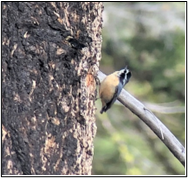

Monitoring Waterfowl Abundance with Camera Traps: Specialist Walker and Worker Clifford deployed eight trail cameras at the Frenchman Regulated Access Area and TD-2 project to continue a waterfowl abundance study. Cameras are attached atop a 20-foot steel pipe which typically requires two people to lift and set in place. Cameras will take one photo per hour during daylight hours until early May to monitor waterfowl use of these project areas.


Experimental Drone Surveys: Data Manager Jansen paved a new direction for the pygmy rabbit team when he came and flew drones over the Palisades area. The drones were taking imagery that will later be used to pick prime release areas. Preliminary data has everyone excited. The team was able to identify burrows from the aerial imagery and then do some ground-truthing. The data also provided WDFW with 3D maps of the area. This will allow us to zoom in on the sagebrush to see which stands are the thickest. The next step will be to fly the drones in areas with pre-existing vegetation data and rabbit burrows.




Rabbit Necropsies: Whenever the team recovers a pygmy rabbit carcass, a DNA sample is taken, and the body is preserved in the freezer until necropsies can be performed. Often, carcasses are in such poor condition that not much information can be obtained. In some cases, a liver sample can be removed and sent to the Washington Animal Disease Diagnostic Laboratory. While it is a very stinky endeavor, it is important for the pygmy rabbit team to investigate every mortality event.
Coccidia Testing: Coccidia is a parasite that resides in the intestines of a rabbit. At certain times of the year, adults will shed this parasite in its poop. This can be particularly dangerous for young kits when it is observed in high levels. Every month during the breeding season, the pygmy rabbit team collects fecal samples from breeding enclosures and inspects them under the microscope. In our most recent sampling, enclosure B3 has tested positive for increased coccidia levels. Luckily, there is a medication called Amprolium that we will administer to treat coccidia.
Kit Searching: Game cameras have been deployed in all the breeding enclosures and on several wild burrows in Beezley Hills and Rimrock Meadows. The burrows were carefully selected by looking at our genetic data results. We chose burrows that showed the presence of females in hopes that we can capture the emergence of kits. Once kits are shown moving on the landscape, the pygmy rabbit team plans on capturing approximately five wild pygmy rabbits and placing them within our breeding enclosures to increase genetic diversity and to increase breeding output for releases.



District 6 Mule Deer Monitoring: Biologists Fitkin and Heinlen wrapped up spring mule deer surveys having classified 1565 animals in the western 2/3 of District 6. The resulting fawn to adult ratio of 20:100 is the lowest observed since the spring of 2007. That is significantly below the 10-year average of 32:100. This indicates higher than average over-winter fawn mortality, which was not too surprising since this past winter was arguably the toughest in the district since the harsh winter of 1996-1997.
Landowner Coordination for Surveys: Biologist Morris and Biologist Cook helped the pygmy rabbit crew and an assistant district wildlife biologist gain access to private property for pygmy rabbit and Washington ground squirrel surveys. More than six private landowners were very willing to cooperate with the department to allow for these surveys to move forward on private ground.


Providing Recreation Opportunities
Hunter Access Program: Biologist Morris worked on updating contracts for Hunting Access so they will be ready for this fall. He also worked on a fishing access contract that the Private Lands Program is taking over from the Lands/Access Program.
Providing Conflict Prevention and Education
Wildlife Area Gates: Biologist McPherson received three new swing gates that were recently made by a local fabricator. The new gates look great and are very sturdy and the fabricator made some new improvements to help with overall function and longevity. The gates are now painted white, and they are ready for installation.

Russian Olive Removal: Wildlife area staff members have been working on burning piles of Russian olive around the Winchester Wasteway. Piles have been aging for two years to help consumption of materials. Focus has been primarily on the eastside due to conditions and the westside will need some preparation work before burning can commence.
Biologist McPherson, Specialist Walker, and Worker Clifford removed a large Russian olive off Sand Dunes Road. This tree usually is a frequent area of nefarious activity since it provides for some seclusion. By removing this tree, we should see a reduction in dumping and people who overstay the 14-day limit on camping.

Department of Ecology Tire Pick Up: Biologist McPherson has been communicating with Department of Ecology tire pick up program for some time now. Due to contracts being inactive for some time, wildlife area staff and Washington Conservation Corps (WCC) crew members have been collecting tires for about two years. Our tire collection has reached about 600 tires. We now have an active contract with Liberty Tire Recycling out of Spokane. They came to our headquarters and finally took the tires off our hands.
Pre-Grazing Season Coordination: Specialist Heilhecker spoke to United States Forest Service (USFS) range staff members for the Methow Valley and Tonasket ranger districts. They discussed wolf locations, range rider availability, and turnout dates.
Deer Damage to Orchard: Heilhecker visited with an orchardist regarding winter deer damage. High snow depths compromised their fence and allowed the deer to jump into the orchard. She recommended the orchardist plow around the outside perimeter of the fence next winter to remove the snow and keep the fence eight feet high. Specialist Heilhecker gave the orchardist information explaining how to file for crop damage compensation.
Sharing of Information: Heilhecker notified two livestock producers of a wolf den location.
Skunk Call: Heilhecker received a call regarding a skunk using a crawlspace under a house. The landowner has tried many times to block the entrances used by the skunk, but the skunk keeps excavating around the barriers. Heilhecker suggested placing ammonia in the crawlspace if no pets or children are in the area. The landowner also set a livetrap to catch the skunk.
Range Rider and Livestock Turnout Coordination: Heilhecker spoke to USFS range staff and a WDFW contracted range rider regarding livestock turnout. The contracted range rider will start riding pastures next week to look for wolf activity before livestock go out on June 1.
Conserving Natural Landscapes
Garbage in District 5: Biologist Clements finished conducting ground squirrel surveys and noticed a spot that along the Lind Coulee that become a spot for dumping. She ended up going on an easter egg hunt and collected six bags of trash, a disintegrating box, and over 20 easter eggs.


Habitat Project Planting: Private Lands biologists began planting water birch in north Douglas County. Biologist Morris checked on plantings from 2021 and 2022. In one area, junipers that were planted are in poor condition. Morris will be brainstorming ideas to improve their condition and survival.
Cooperative Burn: Sinlahekin Wildlife Area Manager Wehmeyer, Methow Wildlife Area Manager Troyer, and North Central Wildfire Prescribed Burn Member Kave participated in the second of three cooperative burns near the Highlands 20 Fire Camp on the Sinlahekin Wildlife Area. The 58-acre (35 acres on Department of Natural Resource (DNR) land and 23 acres on WDFW land) prescribed fire included mostly DNR staff members but both USFS and WDFW staff members assisted within the prescribed burn. WDFW Prescribed Burn Manager Eberlein provided significant assistance in the drafting of the burn plan and staff members also helped brief both groups of staff members prior to burning. One more burn unit remains in the cooperative burn area and could happen sometime this spring.
Lands 20/20 Lands Operations Manager: Lands Operations Manager Haug met with Region 2 and Lands Division staff members to discuss upcoming acquisitions and report on ongoing projects. The group discussed the new process and schedule for the upcoming year. They discussed what projects on their agenda need to remain, which required more work, and which should be removed from consideration.

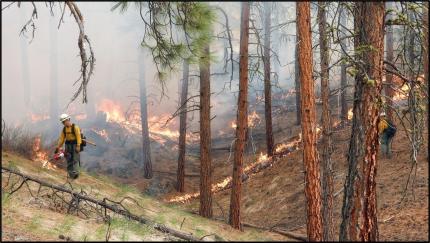
Sinlahekin Habitat Management: Assistant Manager Riley and Natural Resource Specialist White were able to remove approximately 9,000 feet of dilapidated pasture fence on the McLoughlin Unit. Most of the fence was covered with shrubs and grass. It was a combination of field fencing and barbwire fence. Most of it was attached to steel post or pipe with multiple wire ties or high tensile wire. The fencing was a barrier and it posed a threat for wildlife getting caught in it when they went through the area. Sinlahekin staff members also continued annual maintenance of the access site parking lots of various units when weather conditions were conducive to herbicide treatment. This treatment will help prevent noxious weeds from growing in the parking lots and help to minimize potential fire hazards.
Scotch Creek Riparian Restoration and Shrub Enclosure Maintenance: Staff members removed the fence around the exterior boundary of the project area, as the fence is becoming hard to maintain due to deterioration from age and it is no longer effective at keeping deer from browsing newly planted shrubs. Staff members also planted 100 aspen and 50 water birch trees in one of the existing high fence enclosures. Both species are important winter food sources for sharp-tailed grouse.
Staff members spent a large amount of time repairing shrub enclosure fences damaged by heavy winter snow. The heavy snow also damaged existing native riparian shrubs that were planted over the last ten years by breaking branches and smashing limbs down to the soil surface, allowing mice to girdle and strip the bark from the limbs.
Habitat Plots: Private Lands Biologist Cook and Private Lands Tech Blanchard, dumped three additional loads of wood chips on food plots to help improve soil structure and help with moisture retention. They also talked with a landowner about getting him signed up as a wildlife view area and his plans on planting this year.
Biologist Cook and Technician Blanchard visited a site seeded with native grasses in fall 2021. With a dry spring and summer in 2022, the grasses were not fully established in all areas of the field but were present. Some additional herbicide application this year may be needed to assist with full establishment.



Methow Wildlife Area Noxious Weed Control: Assistant Manager Repp has been busy with herbicide applications throughout various locations of the Methow Wildlife Area. Spring showed up late this year, but it’s full steam ahead now. Recently, Repp has been concentrating efforts on commonly traveled roads and parking areas such as Pipestone Canyon, Golden Doe, Wolf Canyon, Bear Creek Campgrounds, Shooting Range, Lewis Butte, and Riser Lake to name a few. Weed control efforts will continue over the coming weeks in some of our shrubsteppe restoration fields as well as the Big Valley.
Methow Wildlife Area Volunteers: Volunteer projects have quickly ramped up with spring finally upon us. Several volunteers have been cleaning out and documenting nest boxes throughout the valley. There’s also been a few volunteers gradually picking away at unnecessary fences around the Big Valley trail system. Additionally, the local chapter of Backcountry Horsemen rebuilt a few sections of buck and rail fencing at the Beaver Creek Campground. Coming up this weekend, Backcountry Hunters and Anglers will be showing up with nearly 30 volunteers to assist Methow Wildlife Area staff in wrecking out barbed and woven wire fences at various locations throughout the wildlife area, followed by a BBQ and campout.
Frenchman Reserve Grazing Fence: During the process of Grant County Public Utility District contractors clearing Russian olives under power lines, the fence lines on reserve boundary were damaged. Since grazing season is quickly approaching, fences need to be repaired to keep cattle contained. To make sure fences were properly repaired, Biologist McPherson coordinated with the Washington Conservation Corps (WCC) crew to make repairs before grazing commenced for the season.
Chelan Butte Field Restoration: Technician Zabreznik was able to drill seed fields on the Chelan Butte that burned in the 2022 Stayman Flats Fire. There is still snow in some areas, and muddy conditions in other areas. The wildflowers are beginning to bloom, sagebrush buttercup, yellowbells and desert parsleys were all seen blooming.
North Wind Aviation was hired to seed the fire breaks by helicopter, and some fire breaks were seeded by hand.
Beebe Springs opened to the public after its seasonal winter closure and has seen regular use.
Providing Education and Outreach
Washington Conservation Corps Weed Workshop: Wildlife area staff members provided a space for a WCC noxious weed workshop at their headquarters. This workshop will allow for all Eastern Washington crew supervisors to gain credits toward their recertification period.

Oroville High School Field Day: Staff members joined Oroville High Schools Greenhouse Management Teacher Vanderwal, and four of her students. They planted cuttings and stakes on a riparian restoration project along Tonasket Creek on the Charles and Mary Eder Unit. The plants were propagated in the school’s greenhouse.
Turkey Season Information: Specialist Heilhecker received a call from an out-of-state hunter. The hunter was interested in suggestions for turkey hunting locations.

2023 North Central Washington Envirothon: WDFW staff members participated in the 2023 Envirothon in Waterville, WA. Private Lands Biologists Braaten, Cook, and Morris and Natural Resource Technician Blanchard manned the wildlife station and assisted in the administration of the wildlife quiz related to area wildlife and habitat to eight high school teams from three schools. Question topics included Aquatic Ecology, Forestry, Soils and Land Use, and Wildlife.


Liberty Bell Career Day: A few weeks ago, Methow Wildlife Area staff were invited to a career day event at Liberty Bell High School. Methow staff members decided to bring all three employees to give students a better idea of some of the different careers that might be available to them if they choose a career in public land management. Local staff members ran into Daley from the local USFS ranger district, and they decided to team up for the event. The Methow crew members brought skulls, hides, and informational materials and Daley brought candy. This combination was hit and the booth was well visited.


Science Technology Engineering Arts and Math in the Field: Lands Operations Manager Haug, Sinlahekin Wildlife Area Manager Wehmeyer, Assistant Manager Riley, Natural Resource Specialist White along with members of the Washington Department of Natural Resources (DNR) and the Methow Beaver Project worked with staff members from the North Central Educational Service District (NCESD), Tonasket Elementary, and Oroville Elementary to hold a Science Technology Engineering Arts and Math (STEAM) field trip to the Sinlahekin Wildlife Area. Over two days, Tonasket and Oroville elementary schools brought over 100 students to the wildlife area. The purpose of these visits was to take their classroom science learning into the field for an authentic science experience.
Students worked alongside agency staff members to collect forestry data, identify important plant species, learn about animal species in the area, and draw their observations above Forde Lake in an effort to learn more about forestry and fire ecology in Okanogan County. DNR Highlands District Manager Townsend, DNR Forester Smith, and DNR Biologist Breitenbach discussed forest management, forest species, instructed them on the use of forestry tools to measure DBH (Diameter at Breast Height), determined tree height, and talked about the importance of forest health. WDFW staff assisted with the planting of native species such as golden current, blue elderberry and serviceberry while discussing the importance of these shrubs to various wildlife and pollinator species. Nelson with the Methow Beaver Project discussed the importance of beavers in our local ecosystems. Thompson from Methow Arts and Haug from DNR instructed students to draw the landscape using charcoal near Forde Lake. Engagement from students was high and comments from teachers and parents were extremely positive.




Conducting Business Operations and Policy
Agricultural Leases: Lands Operations Manager Haug met with Stewardship Section Manager Walls and Range Specialist Burnham to discuss a Methow Wildlife Area agricultural lease renewal as well as various other agricultural leases to begin the discussion on determining future rates to each lessee. More work to come this year on the subject.
Eder Tower: Haug, Scotch Creek Wildlife Area Dupont, and Region 2 Properties and Acquisitions Specialist Huynh met with a representative of the Okanogan County Sherriff’s office to discuss the possibility of deploying a communications tower on the Charles and Mary Eder Unit. Staff members asked for additional information and provided the official with an idea of what the request would take in terms of time and effort. The placement may be approximately two to three years out according to their representative and depends on whether or not their request is funded.
Sinlahekin Maintenance: Sinlahekin staff members continued to prepare equipment for the upcoming field season, Natural Resource Specialist White has been fabricating axles and a hydraulic lift for the harrow seeder that will be used to seed native grass seed on some shrubsteppe restoration sites on the Chiliwist Unit. Staff members will continue with other maintenance activities. They also started annual maintenance of the access site parking lots through the various units of the wildlife area. This treatment will help prevent noxious weeds from growing in the parking lots and help to minimize potential fire hazards.
Scotch Creek Maintenance: Staff members continued doing maintenance and repairs on vehicles, ATVs, small engines, and farm equipment. They also worked with a local vendor to locate and dig up the septic tank in the office yard. The vendor will be back next week to pump it.

Virtual Tour: Haug presented a virtual tour of wildlife areas and water access areas in Okanogan County to the Lands Division at their quarterly meeting. The presentation talked generally about the wildlife and water access areas and touched on successes and challenges. Hopefully, the virtual tours will become a standard segment of each meeting.

Hiring of Natural Resource Technician: Private Lands Technician Blanchard has been completing new employee hiring and orientation and began studying for his pesticide applicator license. Blanchard will increase the capacity for Region 2 Private Lands to install and improve wildlife habitat. Biologist Cook assisted Blanchard with orientation. They visited habitat sites throughout southern Grant and Adams counties. Blanchard will primarily be working on installation and maintenance of habitat improvements in Grant and Adams counties but will also work throughout WDFW Region 2.
State Acres for Wildlife Enhancement Conservation Reserve Program Cancellation: Private Lands Biologist Braaten worked with Olympia staff members on figuring out a solution to State Acres for Wildlife Enhancement (SAFE) workload. Natural Resources Conservation Service (NRCS) delivered news at a monthly meeting with WDFW staff members that they will be canceling our contribution agreement effective immediately. This left a lot of unanswered questions but provided some breathing room for NRCS who is restructuring workload to be ready for the IRA funds coming in October. This means a different approach in managing Department of Agriculture Farm Service Agency’s (FSA) Conservation Reserve Program (CRP). Private Lands Braaten spent several hours contacting landowners and local NRCS working out details. Private Lands staff will still work with and be available to landowners to assist where we can.
Equipment Delivery: Private Lands Biologist Braaten took delivery of new tractor with front loader this week.

Scotch Creek Pivot Clean Up: In 2020, a windstorm blew over the south pivot on the Chopaka Unit. The severely damaged pivot was dismantled and stacked in the corner of the field, spring of 2020. This week staff members removed all the tires, gear box, center drives, drive lines and hauled them to the Eder Unit for storage and reuse. The remaining large pieces of metal and pipe will be picked up by the WDFW construction shop later this spring for recycling.

Scotch Creek Deck Repair: Scotch Creek staff members completed the replacement of all four-posts supporting the awning covering the back porch of the office. The old posts were starting to deteriorate and were compromising the integrity of the awning. Staff members also replaced the deck boards and cover to the domestic well.
Accessibility: Lands Operations Manager Finger participated in a meeting with Bureau of Reclamation staff members to discuss accessibility of sites for people with disabilities. Bureau of Reclamation conducted a field assessment which indicated that a number of sites are out of compliance. Finger is developing a transition plan which will establish goals and timelines for reaching compliance for water access sites location on federal lands and has begun discussions with WDFW Communication and Public Engagement (CAPE) which will hopefully lead to a standardized sign to inform users on where our accessible sites occur. This will likely be done using a QR code to link to our website accessibility page. We will update the website information with georeferenced maps and a description of all Americans with Disabilities Act/ Architectural Barriers Act opportunities.
County Commissioners: Finger accompanied Regional Director Hoenes in a meeting with Grant County Commissioners to discuss three potential acquisition projects and to provide an update on the future development of a target shooting range facility.
Wildfire Coordination Meeting: Finger chaired an annual meeting with local, state, and federal fire protection agencies to coordinate on local access, prescribed burn projects, fire protection contracts, and contact info, etc. in preparation of the upcoming fire season.
Livestock Billing: Biologist McPherson has been receiving livestock reports from grazing permit holders. Now that McPherson has received those billing letters, grazing permit statements and harvest reports can be sent out to permit holders for billing.
Oil and Fuel Recycling: Biologist McPherson coordinated with Safety-Kleen who recycles and picks up both oil and fuel from facilities. Our headquarters are scheduled for pick up on site for our oil, diesel, and gas.
Columbia Basin Wildlife Area Headquarters Yard Maintenance: Wildlife area staff members took an opportunity to do some gravel maintenance work on our laydown yard at headquarters. The newly acquired box scraper and a harrow pulled by truck did a great job of leveling and smoothing out gravel.

Other
New technician: District 7 biologists just welcomed a new biological technician onto their team for the 2023 summer season! Technician Hara will be assisting in greater sage-grouse and sharp-tailed grouse lek counts and lek surveys as well as upcoming Washington ground squirrel surveys.
Red Card Training: Specialist Walker completed the online portion of red card certification through the National Wildlife Coordinating Group. To finish the red card certification training, Specialist Walker will need to complete a day of live fire training and pack test.
Specialist Heilhecker listened to the Wolf Advisory Group meeting and completed mandatory online training for fall protection and hazardous chemicals.
Bobcat Sealed: Specialist Heilhecker sealed two bobcats taken in Game Management Unit 204.
Injured Raptor: Specialist Heilhecker spoke to a landowner regarding an injured raptor. The landowner had no interest in calling the nearest raptor rehabilitator in Kettle Falls. She informed the landowner to leave the raptor alone and let nature take its course.

